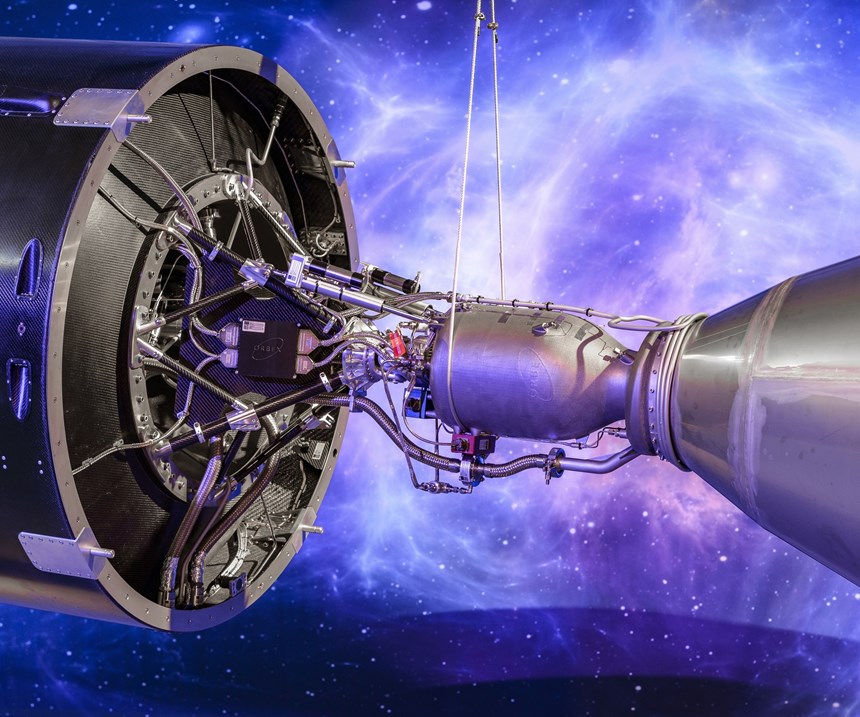SLM Solutions 3D Prints Orbex Launcher
Orbex has built a metal rocket engine 3D printed on SLM Solutions’ selective laser melting machine.
Share
Read Next
Orbex has introduced what it says is the world’s largest metal rocket engine 3D printed in a single piece on the SLM Solutions 800. The UK-based spaceflight company develops small satellite launch vehicles and introduced Prime, an environmentally-friendly rocket at the grand opening of its new headquarters in Forres, Scotland. The 3D-printed Orbex launcher is optimized for selective laser melting (SLM) and said to use 100 percent renewable fuel to cut carbon emissions by 90 percent and a zero-shock staging and payload separation resulting in zero orbital debris. Orbex says it created a structure 30 percent lighter and 20 percent more efficient than other launch vehicles in its category.
Orbex aerospace engineers partnered closely with the applications engineering team at SLM Solutions headquarters in Lübeck, Germany, to ensure success transferring the design into selective laser melting production—a feat that required the partnership of the equipment provider due to the complexity and size of the component.
Lukas Pankiewicz, applications specialist, headed the consulting team inside SLM Solutions to develop a set of parameters optimized for this particular geometry. Working closely with the design team at Orbex, Pankiewicz consulted on the various design features and orientation options, while ensuring the part built successfully with the required material properties and dimensional accuracy. “Our aim during the process was to fulfill the quality expectations of the Orbex team, keep the functionality of the part and make it suitable for additive manufacturing,” Pankiewicz says. “Every single support structure used in data preparation has been customized to obtain the best quality in every section of the engine, taking postprocessing into consideration as well.”
The SLM 800 large-format metal additive manufacturing system features a 260 × 500 mm powder bed that can build parts 800-mm tall, allowing the Prime engine to be built in a special nickel alloy in a single piece. The SLM HUB unpacking system for the SLM 800 integrates contactless powder handling and automated build chamber conveyors to transfer the finished part to an unpacking station designed to remove powder through vibration and rotation. A powder removal strategy was incorporated into the build with purpose driven delivery channels to ensure as much powder was removed from the build as possible while reducing material loss.
After production, reference samples built together with the engine were analyzed in the SLM Solutions’ metallography lab, where porosity level and distribution were proven to meet the quality acceptance criteria. The rapid iteration times inherent to the SLM process allowed Orbex to realize both time and cost reductions—saving 90 percent in turnaround time and over 50 percent in costs compared to traditional CNC machining production, the company says.
Jonas Bjarnoe, chief technology officer of Orbex, says: “The SLM Solutions team showed true dedication and in-depth knowledge of our work. I'm looking forward to continuing this collaboration in 2019 and onwards. Orbex and SLM Solutions have solved some important puzzle pieces which will change the space business.”
Related Content
-
How Norsk Titanium Is Scaling Up AM Production — and Employment — in New York State
New opportunities for part production via the company’s forging-like additive process are coming from the aerospace industry as well as a different sector, the semiconductor industry.
-
Beehive Industries Is Going Big on Small-Scale Engines Made Through Additive Manufacturing
Backed by decades of experience in both aviation and additive, the company is now laser-focused on a single goal: developing, proving and scaling production of engines providing 5,000 lbs of thrust or less.
-
3D Printed Titanium Replaces Aluminum for Unmanned Aircraft Wing Splice: The Cool Parts Show #72
Rapid Plasma Deposition produces the near-net-shape preform for a newly designed wing splice for remotely piloted aircraft from General Atomics. The Cool Parts Show visits Norsk Titanium, where this part is made.
















